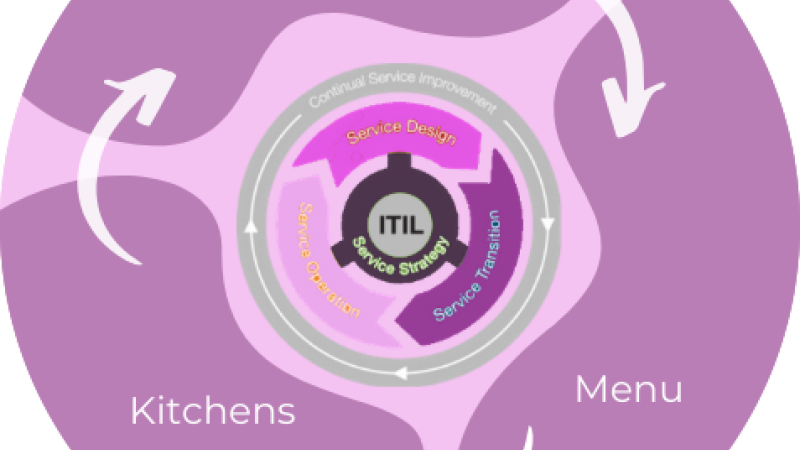ITIL in 10 min


If you search ITIL on Wikipedia, you will find the following:
“ITIL, formerly an acronym for Information Technology Infrastructure Library, is a set of detailed practices for IT service management (ITSM) that focuses on aligning IT services with the needs of business”
Have you understood anything? Well, neither did us.
Nowadays, business and technology are deeply connected. In order to remain competitive, an organization has to consider their corporate goals and IT capabilities equally. The improvement of IT services starts with the awareness of current procedures and management practices inside an organization.
This is what ITIL does, let us explain what it is all about.
What is ITIL?
ITIL is a set of best-practice processes for delivering IT services to customers. The primary focus is to maximize value to customers by aligning IT resources with business needs.
ITIL is composed of 5 books initially, which will be explained hereafter. Nowadays, technology evolves so fast that producing books including ITIL phases would be useless. This is why ITIL processes are now called “frameworks”, as they are changing structures adapted to our reality, subject to very fast changes. Process books are still being published, but they are updated periodically to include all the new information that can be gathered.
Each one of the five frameworks has its subcategories, which can be defined as “little steps” that the company needs to take in order to master ITIL practices.
Right now, you may be a bit confused. What is “this” then? Is it a service, is it a company? Don’t worry, in a few minutes you will be that immersed in this world, you will feel like an expert!
In a few words, ITIL helps businesses to grow, while delivering best practices, putting the focus on adding value to customers, but never forgetting to optimize resources, offer reliable services and do achievable plannings.
Do you want to know what these five frameworks are about? Let’s get to the core of it!

Wanna know a little bit about its history?
You are probably wondering when was ITIL created, well, the concept came out in 1980 in England when the government saw that their IT service was not enough. They entrusted the Office of Government Commerce (OGC) to create a framework for financially responsible and efficient use of IT.
The first version of ITIL was named GITIM which meant Government Information Technology Infrastructure Management. As you can imagine, it was really different from nowadays ITIL but they had a common focus which is service support and delivery.
After some years it became popular and a lot of governments and private companies used it, including Microsoft which used it as the basis to develop their proprietary Microsoft Operations Framework (MOF).
As a lot of years had passed since the creation of the first version and many things in IT had changed, there was an urgent need to create a second version. In 2001 it was released, and it became the most widely used IT service management.
In 2007, ITIL 3 was released, it adopted more of a lifecycle approach to service management, with greater emphasis on IT business integration.
Its last version (ITIL 4) was published in 2019. It embraces the latest trends in service management and technologies and gives a flexible basis and support organizations as they go through a digital transformation.

How to implement ITIL in your business?

It is important that the person applying it is qualified for it and has knowledge of the subject. For that, ITIL certification is recommended. Some companies offer the possibility of getting the certificates or offer the service of helping ITIL implementation for other companies.
Certifications
To be recognized as an ITIL expert and implement it within an organization you will need to get one of the certifications, we recommend you to prepare yourself for the last updated version, ITIL 4! There are four certification levels within the ITIL 4, these are:
- ITIL 4 Foundation Level
- ITIL 4 Managing Professional
- ITIL 4 Strategic Leader
- Master Level
There are two ways to prepare the ITIL Foundation certificate. You can take a training course with an Accredited Training Organization (ATO) and then take the exam or study it by yourself and then book the exam on ITIL Examination Institute.
The price of the exam varies in the country, but it is usually around 400$ plus the preparation courses and the book which are around 500$. It may sound as it is expensive, but it can be a great investment for the future of your company!
Wanna know some examples of ITIL implementation?
NASA
Nowadays, the implementation of ITIL practices in companies is very common; NASA is one of them.
The implementation of ITIL allows them to increase the effectiveness of management and delivery IT services across the agency. This collaborative approach will result in the achievement of “The Best of the Best IT”.
Some of the examples that are a clear implementation of ITIL in NASA are the Service Transition; that is used for the development of new capabilities for transitioning services into operations. Also the Continual Service Improvement is also an important and evident aspect, by the fact that they address highest potential values for customers through better design, the introduction and operation of services, linking improvement efforts with service strategy, design, transition and operation.
All this will help NASA by the improvement of service delivery, mitigating disruptions, increasing productivity and enabling achievement of IT business objectives. Additionally, ITIL addresses new guidance and reporting requirements from the Office of Management and Budget (OMB).
This is how ITIL helps businesses serving their customers better.
Local Restaurant
Now we are going to compare NASA’s implementation to an example that could be applied to any SME, as is the case of a restaurant, on how ITIL can be applied to improve service operation.
According to service operations, a restaurant can improve customer satisfaction through the implementation of a feedback form, so their customers will be asked for the introduction of a new dish after they consume it. Gathering insights from the customers, ITIL helps businesses evaluate services for required improvement.
Related to service transition, a waitress doesn’t have any problem figuring out which dish is for which table as s/he has number cards placed on each dish corresponding to each table. ITIL helps making the implementation of decisions easier for companies.
Also, according to service design, when preparing the dishes, the chef does not need to waste time looking for the ingredients, he has everything organised in the kitchen. ITIL helps in designing the various steps required to implement the decision taken, in this case, organising the ingredients for a new plate easily and accessibly.
And last but not least, a restaurant can also improve service strategy, applying ITIL to the introduction of an idea of a new plate. Firstly, the director of the restaurant suggests a meeting to think on a new plate. This is how ITIL starts with forming a strategy to take a decision that needs to be implemented.

As we have seen with the example, ITIL forms your role in forming strategies, designing the steps needed to implement the strategies, making the necessary changes required to implement the decisions effectively and evaluating the services for any requiring improvement. This allows a continual service improvement cycle, constantly improves the business contribution of the different parts that form it, but also enables organisations to move resources across the enterprise, outsource operations like borrowing staff from a service restaurant to carry an event. This is, ITIL delivers strategic business value with information services using a ITIL blueprint tuned to the needs of the business.
To wrap it up…
ITIL isn’t science. No company can know the specific ROI on ITIL until you implement it within your organization and use it effectively. ITIL is just a framework. But, an improvement in IT will help you achieve your organizational goals. You use IT to improve productivity and efficiency. High-quality IT service management standards are just fundamental to any business success.
We hope that it has been fun for you to understand better the core concepts of ITIL!
About Us!
“Claudia Cordero Canet. I am a curious and creative person that seeks to make my own and singular contribution to the world in order to help as many people as possible while fulfilling their potential. The things I am currently doing in order to get closer to this goal are: leading a local committee that makes possible international exchanges, studying the degree in Business Management and Technology and not stop from following my ideas and projects. @claudiacorderocanet ”
“Natalia Andreea Apostol. I am a young woman, passionate about international development cooperation and leadership, trying to give my best everyday to contribute to the world and its people. https://www.linkedin.com/in/natalia-apostol/ ”
“Laura Schuller Perojo. I am a hardworking and positive student interested in the areas of business applied to the company and smart cities. Once I finish the degree I want to travel some months around the world, collaborating with NGOs and visiting different countries, I think I got so much to learn from the different cultures!! In the future, I would love to create a company and of course, be an inspiring leader. @lauraschuller_ ”
“Carmen Caro Pérez. I am a management and technology student who hopes to loves learning new things. My goal in live is to evolve as much as I can as a person and to try to give my best to the world. I firmly believe in psychology and art. https://www.linkedin.com/in/carmen-caro-pérez ”
“Joaquin Wu Lin. An explorer, a lifelong learner, a life-enthusiast trying to fulfill my potential to live my dream life. What I envision for my career is a place where I can grow, work with inspiring people and do something that contributes to the world. My core values are freedom, joy, connection, contribution & simplicity. @joaquinwulin ”
“Mariana Varela Martinez. I am a management and technology student, I am passionate about programming and a technology lover. In the future I would like to work on something related to programming or AI. Love dancing flamenco and kayaking. linkedin.com/in/marianavarelamartinez”
References
Edmocha. ITIL explained in 3 minutes. Recovered 29/04/2020. Retrieved from: https://www.youtube.com/watch?v=vp2wfoVRMDE
IBM. (2019) “IT Infrastructure Library (ITIL)”. Recovered 28/04/2020. Retrieved from: https://www.ibm.com/cloud/learn/it-infrastructure-library
ITIL central.(n.d.). “In A Nutshell: A Short History of ITIL”. Recovered 08/05/2020. Retrieved from: https://itsm.fwtk.org/History.htm
Marce Feoli. ITIL – A Simple Explanation. Recovered 29/04/2020. Retrieved from: https://www.youtube.com/watch?v=hhTQhf6_Fw0Unknown.
Servicetonic.(2019) “9. Implementando ITIL”. Recovered 28/04/2020. Retrieved from: https://www.servicetonic.com/es/itil/9-implementando-itil/
Simplilearn. (2020) “ITIL: Key Concepts and Summary”. Recovered 6/05/2020.
Retrieved from: https://www.simplilearn.com/itil-key-concepts-and-summary-article
Unknown. “ITIL® Certifications”. Recovered 29/04/2020
Retrieved from: https://www.axelos.com/certifications/itil-certifications
Unknown. (2010). “ITIL: Enabling NASA’s Best Practices in IT Service Management and Delivery”. Recovered: 27/ 04/2020. Retrieved from: https://www.nasa.gov/offices/ocio/ittalk/06-2010_itil.html
Unknown.(2020).”ITIL” Recovered: 29/04/2020 Retrieved from: https://en.wikipedia.org/wiki/ITIL

